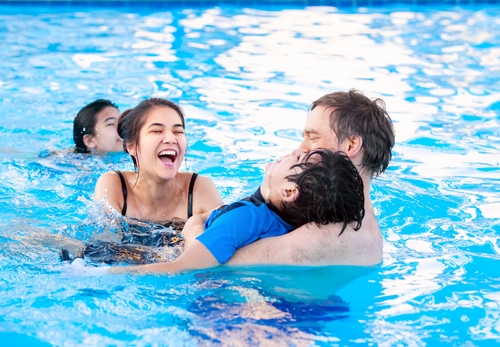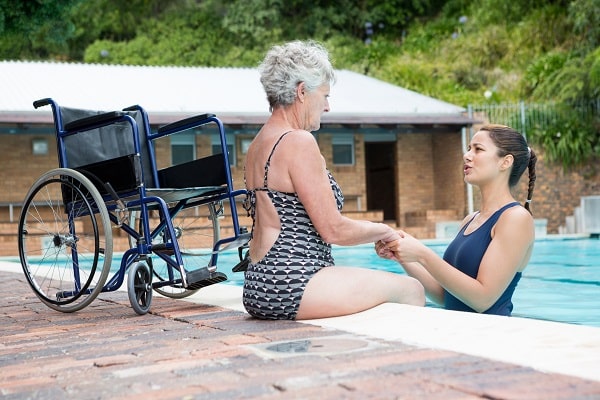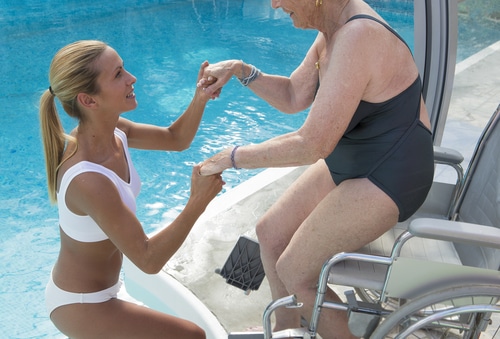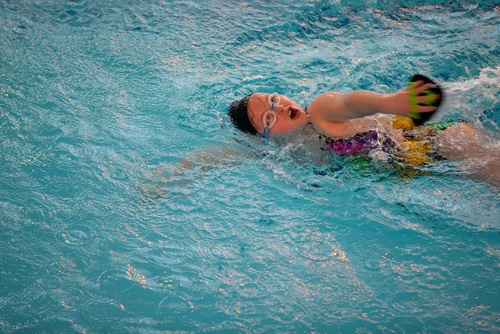If you’re thinking about diving into the world of adaptive aquatics and swimming, you couldn’t have picked a better time! With the sun shining and the water calling, it’s the perfect season to explore how swimming and water-based activities can be adapted to suit all abilities.
Whether you’re new to the pool or looking to renew your love for the water, we’ve got you covered.
In this article we’ll guide you through the basics of getting started with adaptive aquatics – from what it is and who it’s meant for to the types of exercises involved and how to find an adaptive swimming program in Australia.
In this article
What is it?
Adaptive aquatics is basically swimming but tweaked to fit the needs of people with various disabilities. It’s all about making swimming and water activities accessible and fun for everyone, no matter what their physical or cognitive abilities might be.
In adaptive aquatics, instructors often use specialised techniques and equipment to help individuals living with disability learn and take part in swimming and other water activities.
This might include using things like floatation devices for those who need extra support (read more about exercising with limited mobility in and out of the water), or sign language for those who are deaf or hard of hearing.
The great thing about adaptive aquatics is that it’s not just about learning to swim. It’s also a fantastic way for people living with disability to get some exercise, build confidence, and have a bit of fun in the water. Plus, it’s a brilliant way to meet new people and be part of a community.
Whether you’re dealing with a physical impairment, sensory issues, or a learning difficulty, adaptive aquatics opens up a world where the water’s not a barrier, but a playground.
Who is adaptive aquatics for?
Adaptive aquatics is for anyone who can’t take part in traditional swimming lessons or water activities due to a disability. This can include people with:
Physical disabilities or limitations
Whether it’s a mobility issue, spinal cord injury, a muscular condition, or any other physical impairment, adaptive aquatics can be tailored to meet these specific needs. Older adults too, especially those with age-related physical limitations, can benefit from the gentler, more accommodating approach of adaptive aquatics.
Sensory disabilities or disorders
For those who have hearing or visual impairments, adaptive aquatics programs can offer specialised instruction and support. So too for people who have difficulty processing sensory stimuli.
Intellectual or developmental disabilities
Adaptive aquatics can be a great fit for individuals with intellectual disabilities, autism, or other developmental challenges, offering a safe and understanding environment to learn and enjoy water activities.
Chronic health conditions
Those who have chronic health conditions that affect their ability to take part in regular swimming or water sports might find adaptive aquatics a good alternative. This could range from autoimmune arthritis to multiple sclerosis to cerebral palsy.
All kinds of needs for special accommodations
Essentially, this kind of exercise is for anyone who’d benefit from a more personalised approach to swimming and water activities. Instructors make sure participants can take part, be safe, and have fun no matter what their skill level.
Adaptive aquatics recognises that everyone’s abilities and needs are different, and it aims to provide a welcoming and inclusive environment for all to enjoy the benefits of being in the water.

What are the benefits?
Aquatics can have amazing benefits for people of all ages and abilities for many reasons. Here are some of them:
Improved mobility and range of motion
The buoyancy of water reduces the pressure on the body, making it easier to move and exercise. This can help ease the strain for people with disability who have a hard time with movement due to pain, spasticity, or weakness.
Increased muscle strength and endurance
The resistance of water provides a challenge that can help strengthen muscles and improve endurance. This can be great for people who have muscle weakness or wasting.
Reduced pain and inflammation
The warmth of the water can help to relax muscles and reduce pain and inflammation. This can be helpful for people living with disability who have chronic pain conditions such as arthritis or fibromyalgia.
Improved balance and coordination
The unpredictability of the water environment can help to improve balance and coordination. This can be valuable for those who struggle with balance or who are at risk of falls. Also read about surfing with disability which is great for balance, coordination and those who love the water.
Enhanced cardiovascular fitness
Water-based exercise can be a good way to improve cardiovascular fitness without putting too much stress on the body. This can help those who are overweight or obese or who have heart disease.
Improved mental health
Aquatic therapy also has benefits for mental health. The warm water and gentle movements can reduce stress and anxiety and improve mood.
In addition to the physical benefits, aquatic therapy can provide a range of social benefits as well as emotional benefits. Getting involved with group aquatic therapy classes can help you to connect with others, make friends, and feel more supported.

Adaptive aquatics exercises
In adaptive aquatics, the exercises are varied and tailored to suit different needs. But to give you an idea of what you could possibly expect to do in an adaptive swimming session, here are some common ones:
Water walking or jogging
This is a low-impact exercise where you walk or jog in the water. It’s great for building endurance and doesn’t put too much strain on the joints.
Leg and arm stretches
These are usually done while sitting on a pool ledge or standing in shallow water. These movements can be wonderful for improving flexibility and range of motion.
Floating exercises
With the help of floatation devices, these exercises focus on relaxing and stretching in the water. They’re especially good for those who need support to stay afloat.
Water aerobics
This can include a variety of movements like arm circles, leg kicks, and other aerobic exercises, often done to music. It’s a fun way to get some cardio in and can be adapted to different ability levels.
Strength training with water weights
Using special weights that are designed for water use, these exercises help build muscle strength without putting too much pressure on the body.
Balance exercises
These might involve standing on one leg or doing other activities that help improve balance and core strength.
Swimming or floating with assistance
For those who are learning to swim or who enjoy floating, this can be a relaxing and enjoyable part of adaptive aquatics.
Each exercise is adapted to meet individual needs so that everyone can take part safely and get the most out of their time in the water.
Where can I do adaptive aquatics in Australia?
In Australia, there are quite a few places where you can take part in adaptive aquatics. Most major cities and many regional areas have places that offer these programs. Here’s where you can look:
Local councils and community centres
These spots may have swimming pools that offer adaptive aquatics programs. Trained instructors who understand the specific needs of people living with disability often run them.
Specialised swimming schools
Some swimming schools across Australia focus specifically on teaching people living with disability. They usually have specially trained staff and the right equipment.
Rehabilitation centres and hospitals
Some of these places also offer aquatic therapy as part of their services, which is similar to adaptive aquatics.
Disability organisations
Places that support people living with disability often have information about adaptive aquatics programs in your area.
Online lists and other resources
Websites dedicated to disability services in Australia can also be a good place to find local programs.
Remember, it’s always clever to contact any potential facility first to discuss your specific needs and find out about the programs they offer. They can give you information about the accessibility of their pools, the qualifications of their instructors, and the types of programs they have available.

Find out more
Want to find out more about sports, classes or special programs you or your child can take part in? Check out these resources:
- 8 Wheelchair Sports Worth Watching and Playing
- Getting Kids Into Adaptive Sports – What’s Out There?
- Disability Sports and Recreation Options for NDIS Participants
- Activate Inclusion Sports Days Teaching Important Lessons to So Many
Insurance for peace of mind
Whether you’re on your way to an aquatics session or simply at home, you’ll get great peace of mind through protecting your mobility equipment and vehicle.
Not only does Blue Badge Insurance offer wheelchair insurance and mobility scooter insurance, we also offer up to 25% off disability car insurance. Not to mention insurance for wheelchair accessible vehicles and disability converted cars. Find out how each helps cover the costs of repairs and replacement for your mobility equipment or vehicle.








